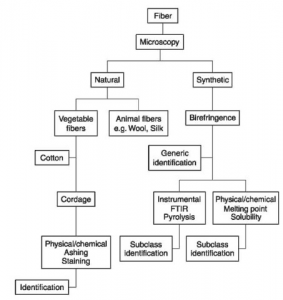Trace evidence is usually found when two objects touch or when small particles are disbursed by an action or movement allowing them to persist on individuals and items. Trace evidence is typically a microscopic substance with unique and identifying features. To put it simplest Dr. Edmond Locard a forensic science pioneer stated, “Every contact leaves a trace’. From this, the concept of trace evidence was found. Some examples of commonly found trace evidence at scenes include:
- Hair
- Fibres
- Glass
- Paint
- Soil
- Footwear Marks
When these examples of trace evidence are recovered some sort of forensic analysis has to be carried out to examine the unique features of these given samples. The types of evidence we will look at specifically are the most common which include: glass, fibres and hairs.
Glass
Glass can persist in lots of shapes and sizes especially when broken, this ranges from large shards to microscopic little pieces. Usually in relation to crimes, these microscopic glass shards persist on the suspects clothes and potentially hair. However, because glass can come in different forms e.g. float, tempered, smart, safety, patterned and so forth it can be difficult to differentiate them when all you have is a small microscopic piece of glass.
The unique identifying feature of glass is its Refractive Index (RI), every unique glass possesses a unique RI. This can be examined by using a machine known as Glass Refractive Index Measurement System (GRIMM), this allows trace evidence glass to be compared reliably against control samples of glass to see whether they match. Other emerging techniques are also being used, these focus on more the elemental or molecular composition. These include:
- Scanning electron microscopy‐energy dispersive X‐ray spectrometry (SEM‐EDX)
- X‐ray fluorescence spectrometry (XRF)
- Inductively coupled plasma‐optical emission spectrophotometry (ICP‐OES)
- Inductively coupled plasma‐mass spectrometry (ICP‐MS).
Fibres
Fibres are individual filaments originating from a larger fabric source or piece like an item of clothing. Fibres fall into two main classifications: natural (animal or plant fibres) and synthetic (completely man-made products). Fibres are a mass commodity and one fabric item could hold lots of different fibres originating from different things. The problem with fibres is that they can transfer across multiple people and their items of clothing from one way or two-way transfer, this makes is hard to determine exactly how they got there and who made what contact with each other due to the mixing of various different fibres.

The form of forensic analysis to identify fibres includes a range of microscopes usually to examine what the fibre is actually made of and if it is synthetic or natural. Cases with fibre evidence will take some control fibres from a victim’s clothing and then try to look for these from tapings of suspects clothing or other items. This is originally done under a low power microscope (10X-40X magnification) to mark any similar looking fibres, these are then picked and can undergo further examination. Usually, Forensic labs will have a series of steps to determine the specific fibre type which includes a range of examinations under a microscope to examine special characteristics of that fibre, a general outline can be seen by the diagram. Other microscopes like high power comparison microscope, polarising microscopes and Microspectrometry (MSP) are used to examine certain characteristics which help determine the fibre type like:
- Colour in transmitted white light
- Colour/intensity of any transmittance of any fluorescence in UV and blue light
- Thickness
- Surface features (scales/damage features/irregularities)
- Dye in the fibre
- Birefringence
Hair
Hair can be classified into human or animal hair, if it is found to be human hair the type then needs to be determined which will either be lanugo, vellus or terminal hair. Humans have lots of different hair on their body and it is important to identify where on the body that hair came from. To forensically examine this type of trace evidence the process is similar to fibres in using a variety of microscopes, these include: transmitted light microscope (40X-400X), stereomicroscope (100X) and comparison microscope. This allows the hairs to be examined and compare to control hairs looking at specific morphology like: degree of curl, shaft length, Colour, shaft configuration, cross-sectional shape, pigment distribution, hair diameter and cuticle.
Some of these processes to examine trace evidence can take a considerable amount of time, see how Eviscan significantly reduces the time taken to forensically examine and enhance fingerprints. Be sure to check out the rest of the Eviscan site for the latest information on latent print detection and recovery Technology.



